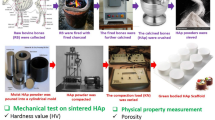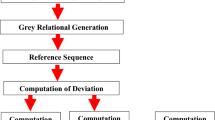Abstract
Physicochemical properties of hydroxyapatite (HAp) synthesized by the chemical precipitation method are heavily dependent on the chosen process parameters. A Box-Behnken three-level experimental design was therefore, chosen to determine the optimum set of process parameters and their effect on various HAp characteristics. These effects were quantified using design of experiments (DoE) to develop mathematical models using the Box-Behnken design, in terms of the chemical precipitation process parameters. Findings from this research show that the HAp possessing optimum powder characteristics for orthopedic application via a thermal spray technique can therefore be prepared using the following chemical precipitation process parameters: reaction temperature 60 °C, ripening time 48 h, and stirring speed 1500 rpm using high reagent concentrations. Ripening time and stirring speed significantly affected the final phase purity for the experimental conditions of the Box-Behnken design. An increase in both the ripening time (36-48 h) and stirring speed (1200-1500 rpm) was found to result in an increase of phase purity from 47(±2)% to 85(±2)%. Crystallinity, crystallite size, lattice parameters, and mean particle size were also optimized within the research to find desired settings to achieve results suitable for FDA regulations.







Similar content being viewed by others
References
M. Vallet-Regi, Ceramics for Medical Applications, R. Soc. Chem. Dalton Trans., 2001, 2, p 97–108
S.W.K. Kweh, K.A. Khor, and P. Cheang, The Production and Characterization of Hydroxyapatite (HA) Powders, J. Mater. Process. Technol., 1999, 89–90, p 373–377
V.P. Orlovskii, V.S. Komlev, and S.M. Barinov, Hydroxyapatite and Hydroxyapatite-Based Ceramics, Inorg. Mater., 2002, 38, p 973–984
R.A. Young and D.W. Holcomb, Variability of Hydroxyapatite Preparations, Calcif. Tissue Int., 1982, 34, p 17–32
F. Fazan, “In Vitro Behaviour of Plasma Sprayed Hydroxyapatite Coatings,” Ph.D. Thesis, University of Birmingham, Birmingham, 2000
V. Deram, C. Minichiello, R.N. Vannier, A. Le Maguer, L. Pawlowski, and D. Murano, Microstructural Characterizations of Plasma Sprayed Hydroxyapatite Coatings, Surf. Coat. Technol., 2003, 166, p 153–159
A.D. Papargyris, A.I. Botis, and S. Papargyri, Synthetic Routes for Hydroxyapatite Powder Production, Key Eng. Mater., 2002, 206–213, p 83–86
J.L. Xu, K.A. Khor, Z.L. Dong, Y.W. Gu, R. Kumar, and P. Cheang, Preparation and Characterization of Nano-Sized Hydroxyapatite Powders Produced in a Radio Frequency (rf) Thermal Plasma, Mater. Sci. Eng. A, 2004, 374, p 101–108
R. Kumar, P. Cheang, and K.A. Khor, RF Plasma Processing of Ultra-Fine Hydroxyaptite Powders, Mater. Process. Technol., 2001, 113, p 456–462
FDA, Calcium Phosphate (Ca-P) Coating Draft Guidance for Preparation of FDA Submissions for Orthopedic and Dental Endosseous Implants, Food and Drug Administration, Washington, DC, 1992, p 1–14
“Standard Specification for Calcium Phosphate Coatings for Implantable Materials,” ASTM F1609, American Society for Testing and Materials, 2003
“Implants for Surgery: Hydroxyapatite—Part 1: Ceramic Hydroxyapatite,” ISO 13779-1, International Standards Organisation, 2000
“Standard Specification for Composition of Hydroxylapatite for Surgical Implants,” ASTM F1185, American Society for Testing and Materials, 2003
A. Afshar, M. Ghorbani, N. Ehsani, M.R. Saeri, and C.C. Sorrell, Some Important Factors in the Wet Precipitation Process of Hydroxyapatite, Mater. Des., 2003, 57, p 197–202
M.R. Saeri, A. Afshar, M. Ghorbani, N. Ehsani, and C.C. Sorrell, The Wet Precipitation Process of Hydroxyapatite, Mater. Lett., 2003, 57, p 4064–4069
J.F. Conn and L.A. Jessen, Process for Producing Hydroxyapatite, U.S. Patent 4,324,772, 1982
I. Smiciklas, A. Onjia, and S. Raicevic, Experimental Design Approach in the Synthesis of Hydroxyapatite by Neutralization Method, Sep. Purif. Technol., 2005, 44, p 97–102
S. Lazic, S. Zec, N. Miljevic, and S. Milonjic, The Effect of Temperature on the Properties of Hydroxyapatite Precipitated from Calcium Hydroxide and Phosphoric Acid, Thermochim. Acta, 2001, 374, p 13–22
S. Kehoe and J. Stokes, Design of Experiments Study of Hydroxyapatite Synthesis for Orthopaedic Application Using Fractional Factorial Design, J. Mater. Eng. Perform., under review
S. Chatterjee and B. Price, Regression Analysis by Example, 2nd ed., Wiley and Sons Inc, New York, 1977, p 200–202
S. Koutsoploulos, Synthesis and Characterization of Hydroxyapatite Crystals: A Review Study on the Analytical Methods, J. Biomed. Mater. Res., 2002, 15, p 600–612
K. Rogers, The Use of Diffraction for the Analysis of Biomaterials, 2nd Annual Biomaterials Workshop, Cranfield University, UK, 2004
D. Rocak, M. Kosec, and A. Degen, Ceramic Suspension Optimization Using Factorial Design of Experiments, J. Eur. Ceram. Soc., 2002, 22, p 391–395
C. Kothapalli, M. Wei, A. Vasiliev, and M. Shaw, Influence of Temperature and Concentration on the Sintering Behaviour and Mechanical Properties of Hydroxyapatite, Acta Mater., 2004, 52, p 5655–5663
M. Giulietti, M.M. Seckler, S. Derenzo, M.I. Re, and E. Cekinski, Industrial Crystallisation and Precipitation from Solutions: State of the Technique, Brazil. J. Chem. Eng., 2001, 15, p 423–440
Acknowledgment
This work is supported under the EMBARK Initiative Scheme by the Irish Research Council for Science and Engineering (IRCSET).
Author information
Authors and Affiliations
Corresponding author
Rights and permissions
About this article
Cite this article
Kehoe, S., Stokes, J. Box-Behnken Design of Experiments Investigation of Hydroxyapatite Synthesis for Orthopedic Applications. J. of Materi Eng and Perform 20, 306–316 (2011). https://doi.org/10.1007/s11665-010-9671-8
Received:
Revised:
Published:
Issue Date:
DOI: https://doi.org/10.1007/s11665-010-9671-8




